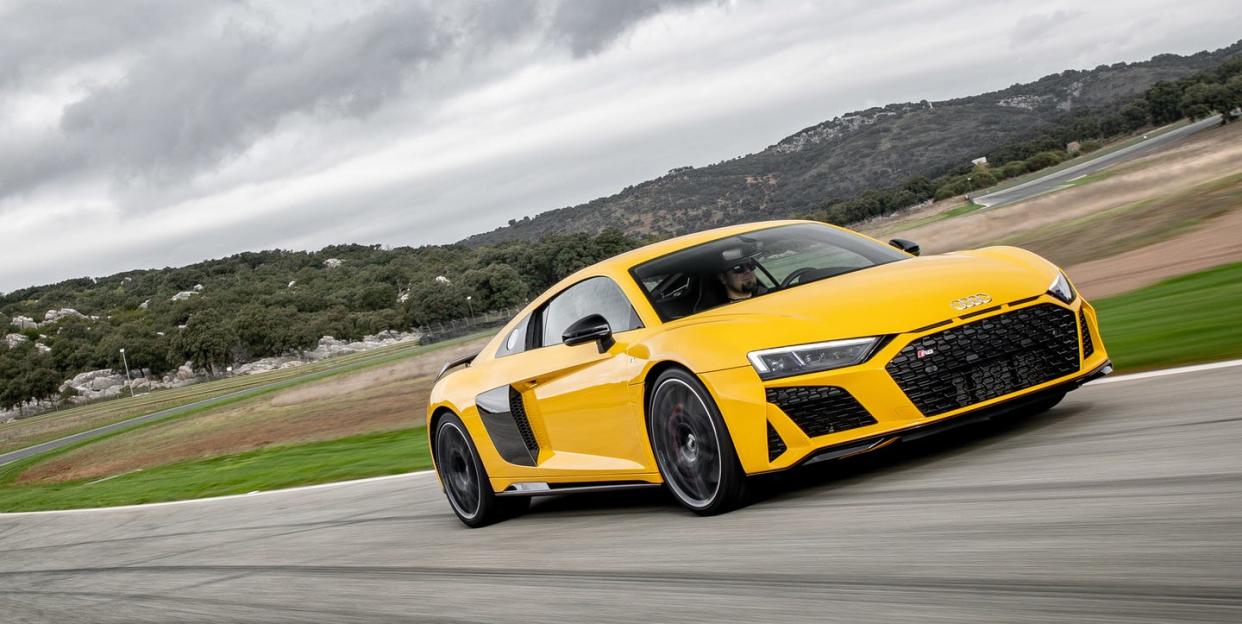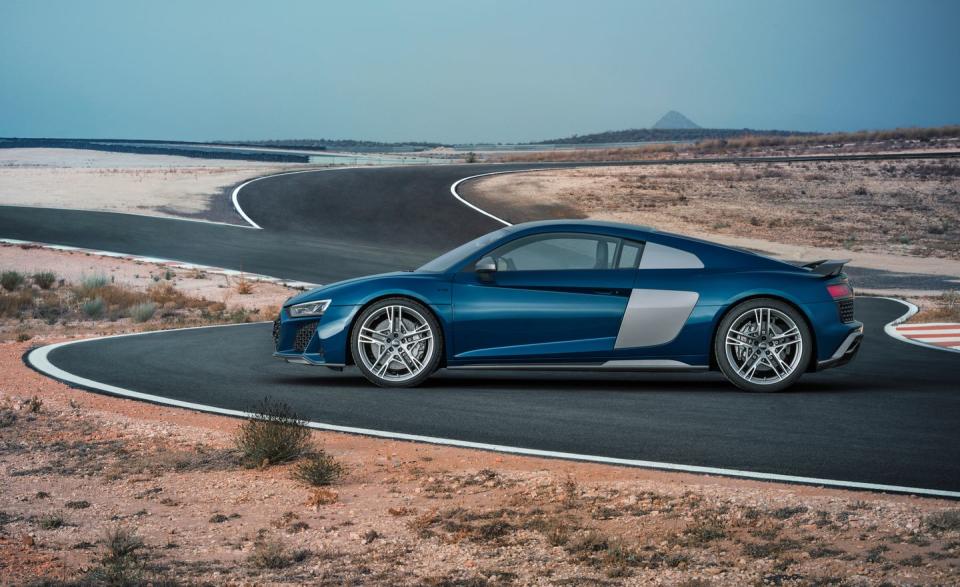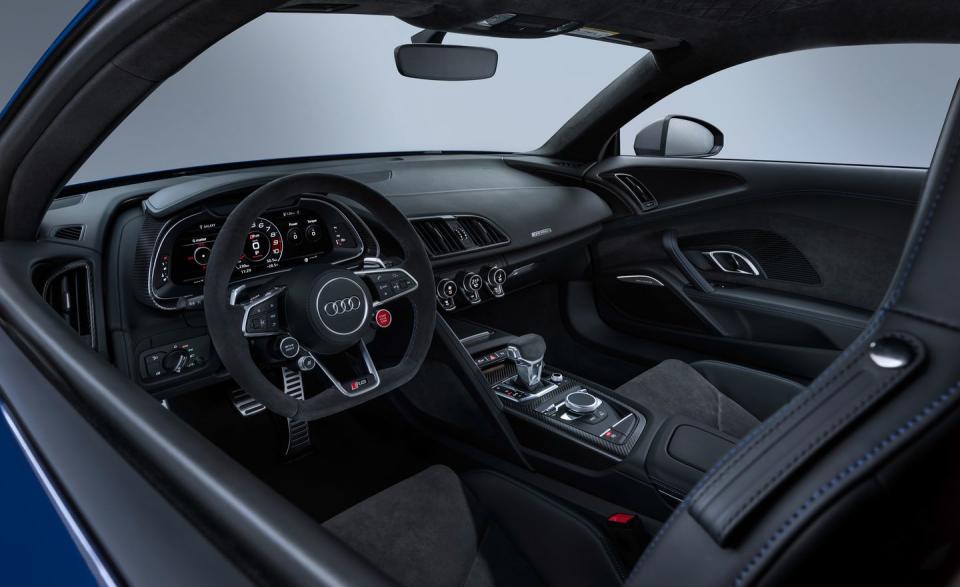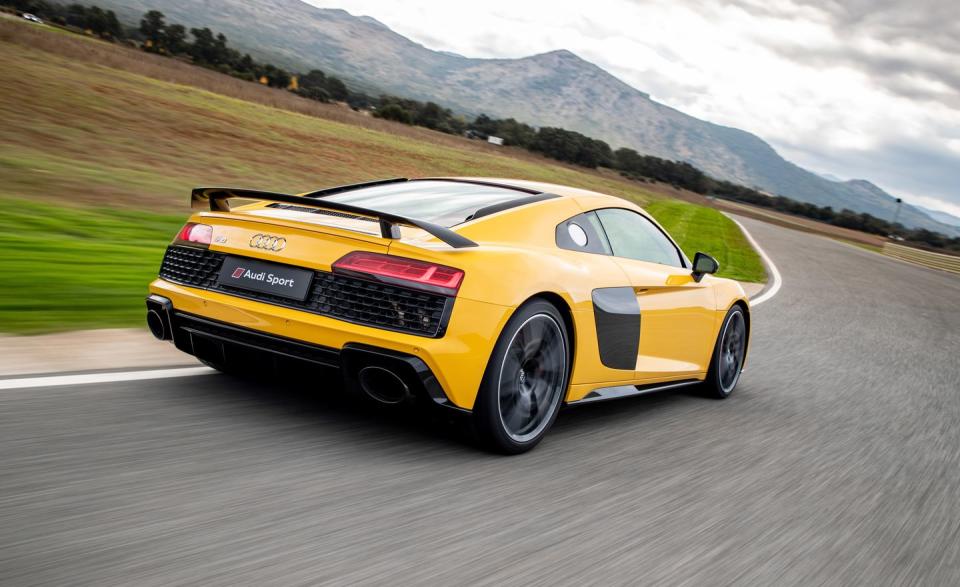The 2019 Audi R8 Is a 600-HP Wallflower among Supercars

It might seem churlish to start a review of a car as talented as the Audi R8 with a digression into taxonomical semantics, but the question of whether we should regard it as a particularly brawny sports car or whether it achieves the realm of a supercar sums up the wider confusion about just where it sits in the market.
On one hand, the R8 shares much of its underbody structure and its howling V-10 engine with the Lamborghini Huracán, the supercar bona fides of which can't be questioned. On the other, it wears an Audi badge, and despite the best efforts of that glorious V-10, its power outputs today seem modest when other supercars increasingly break the 700-hp barrier. The current model of the regular R8 has a mere 532 horsepower, and the Plus version just clears the 600-hp mark with 602.
While we acknowledge that such concerns seem ridiculous when considered against the sonorous charms of the high-revving engine itself, they clearly matter to some. Audi is rolling out a facelifted version, which arrives in the United States in summer 2019, likely as a late-arriving 2019 model. In Europe, the update brings a gasoline particulate filter to help clean the V-10's tailpipe emissions and titanium valvetrain components that help raise output in the standard version to 561 horsepower, while the new Performance model (which replaces the Plus in the lineup) boasts 611 horses. It's unclear, however, whether the U.S. car will get those engine tweaks.
Cosmetically, the revised R8 is distinguished by more angular front styling, with bumpers incorporating upright winglet-style elements on both sides and a wider and hungrier-looking grille. Above this there are three smaller intakes which we're told are a reference to the Sport Quattro, a Group B rally legend of many years ago. Expect this design signature to roll out across multiple future Audi models. At the back are a bigger diffuser and two oval tailpipes in place of the current car's flat-edged outlets. Except for some minor trim tweaks, the interior is effectively unchanged.
Track Time
Our drive in the new R8 Performance coupe was limited to the track at the Ascari Race Resort in southern Spain. We used a truncated layout-leaving parts of the circuit free for photography-and also had to pass through pit lane on each lap, presumably to ensure we weren't having too much fun. We did, however, get to experience two versions of the car, one with the optional active steering and one without.
You'll be unsurprised to hear that the driving experience is close to what we remember of the outgoing R8. The engine remains the star of the show. Although unable to match the boosty low-down shove of its turbocharged rivals, it responds to the smallest throttle input without hesitation and has both the willingness and the enthusiasm to explore the upper reaches of its rev range-all the way until the limiter bites at 8800 rpm. It doesn't have the snarl of the Huracán, but unlike the Lamborghini, which gets shouty at the top end, the Audi's noise seems entirely natural when being worked hard. Nor does it ever feel short on straight-line performance.
Corners show off the R8's modest tally of suspension revisions. While the spring rates and damper tuning are unchanged, the front end features an optional anti-roll bar made from carbon fiber and aluminum that shaves four pounds. As before, the active steering effectively alters the steering ratio with a mechanical device in the steering column, quickening reactions at lower speed and making the rack slower at higher speeds for stability. This gives very quick reactions in tighter turns, but the sense of the steering slackening takes some getting used to. Choosing the Performance drive mode locks it into a fixed 14.0:1 ratio. By contrast, the regular steering setup feels, well, regular-requiring more input but also feeling more natural.
As before, the R8 majors in brutal efficiency rather than any of the fulsome driver flattery that some rivals are programmed to deliver. It gets things done in a serious fashion. The Quattro all-wheel-drive system maximizes traction rather than giving any sense of its claimed rearward bias. The R8 Performance's stability-control system now boasts three additional modes, accessible once the car is turned to its own Performance setting: Dry, Wet, and Snow. None of these make it overtly playful, but it certainly seems to shrug off the challenge of hard track use.
The brakes remain disappointing. The Performance has carbon-ceramic rotors as standard, but they're addressed by a pedal that is generously boosted and lacks the feel necessary for real confidence on track. They certainly work well, but they add to the car's slightly aloof vibe.
Is the R8 Fading Out?
The current-generation R8 is only three years old, but it already feels as if it is on the expressway to retirement. Audi has said it is not going to proceed with the partly developed V-6 version that it was previously working on. We also know that the Huracán replacement will be switched to a hybrid powertrain that likely would be too expensive for the R8, and Audi has admitted it has no current plans to replace the car. It remains a hugely talented and hugely likable performance machine. Our previous experience suggests that this one will perform better on the road than it does on the track. These modest revisions will reach the U.S. next year, but we suspect the R8 will remain a car that many potential buyers will only glance at on their way to more exotic alternatives.
('You Might Also Like',)




